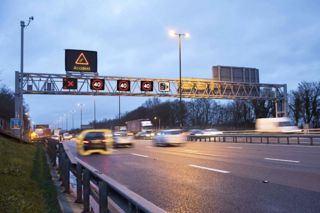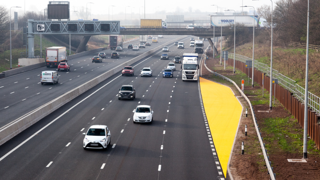Emergency services have joined forces with National Highways to remind drivers not to ignore the red X sign after one council revealed it had prosecuted almost 10,000 drivers.
The red X is used to close lanes when an obstruction such as a broken-down vehicle is detected in the road ahead.
Abiding by the signal is vital to avoid a potentially serious collision.
Chief Constable Jo Shiner, the National Police Chiefs' Council lead for Roads Policing, said: “Red X signals are in place on the motorway for your safety and the safety of others.
“Sadly, there are too many instances where motorists fail to comply with a red X signal and put others in incredible danger by driving in a closed lane. This is unacceptable and drivers who do so need to understand they face prosecution.”
In June 2019, there was a change in legislation which meant cameras can automatically detect vehicles that ignore a red X and as of September last year all police forces have been able to enforce the cameras.
The cameras can be used to automatically detect vehicles passing illegally under a red X or entering the lane beyond a red X, which can result in a fixed penalty of up to £100 and three points or, in some cases, more severe penalties or a court appearance.
The majority of drivers – more than 90% – comply with the red X, although thousands have been prosecuted for not doing so, according to National Highways.
Surrey Police was one of the first forces to begin enforcing camera detected red X offences in November 2019.
Since then, there have been 9,427 first Notices of Intended Prosecution sent out by the force.
Of these, over half – 4,926 – have so far completed a safety awareness course, while others selected alternative disposal options such as paying a fixed penalty or having the matter heard at court.
RAC road safety spokesman Simon Williams said: “This is a very worrying statistic. For some time we’ve been concerned that red Xs displayed on signs at the side of the road aren’t nearly as clear as those positioned on gantries directly above each lane.
“We fear this may be a factor in some of the non-compliance. For this reason, it would be helpful to know drivers’ reasons for not obeying red Xs.
“If it’s the case drivers say they hadn’t seen or understood signs at the side of the road then there may be an argument for installing more expensive gantry signage.
“It’s critical drivers obey the red X as it’s often the first line of defence for anyone stranded in a live lane of smart motorway traffic.”
Association of Ambulance Chief Executives (AACE) managing director, Martin Flaherty, says it is important to remember that 999 ambulances on blue lights may be trying to reach critically ill patients on motorway lanes where red X signals are in force, for example, after a serious road traffic collision.
“If those lanes are blocked by drivers who should not be there, ambulance crews could be delayed in reaching patients who urgently need our life saving skills,” he added.
“We want drivers to understand that a lane closed by a red X is for the safety of all – and especially to help protect the scene of an accident and those emergency and essential services who may be on the carriageway to deal with the aftermath.”
The message was the same from Dan Quin, road lead for transportation at the National Fire Chiefs Council.
He explained: “When used in the event of emergencies, they provide invaluable access to the scene of an incident, preventing time lost in negotiating the build-up of traffic.
“Red X signals also provide safety for workers while on the road, including emergency services and the public, by reducing the risk of further collisions.
“Ignoring red X signals is dangerous, it is an offence, and all road users have a role to play in complying with them.”
It has been an offence for more than two decades to drive in a lane closed by a red X.
National Highways traffic officer, Dave Harford, said: “We don’t take the decision to close lanes lightly, but when we do, drivers must obey the closure.
“A red X signal is there for the safety of everyone on the road – including people in difficulty, traffic officers, recovery and emergency services helping them, and all other road users besides.
“Thankfully, the vast majority of drivers do comply with the signals but those who don’t put themselves and others at risk.”
National Highways says that if your vehicle has a problem, or you get into trouble on a motorway, stay calm and try to exit at the next junction or motorway service area.
If that’s not possible, put your left indicators on, move into the left lane, enter the next emergency area, or hard shoulder, put your hazard lights on, get behind a safety barrier where there is one and keep well away from moving traffic.
Drivers should also call National Highways on 0300 123 5000 then a breakdown provider for help.
If you are unable to exit your vehicle and get to a safe place, have stopped in a live traffic lane or feel your life is in danger, National Highways says that you should stay in your vehicle with your seatbelts and hazard lights on and call 999 immediately or press the SOS button in your car.
Antony Kildare, CEO IAM RoadSmart, says it is “quite simple”.
“A red X means trouble ahead and has exactly the same legal force as a red traffic light.
“With new technology the police can take action and you can be fined and have points placed on your licence. It’s just not worth the risk to gain a few places in the queue.”
























Login to comment
Comments
No comments have been made yet.